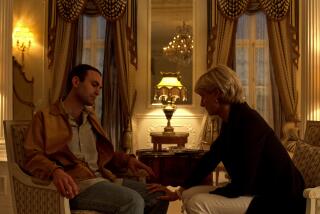Diana Returns to Village in a Sad Homecoming
- Share via
GREAT BRINGTON, England — This is a different village from what it was in the days when the seventh Earl Spencer, grandfather of Diana, princess of Wales, was alive and presiding over the gargantuan grounds of the nearby Althorp estate--a little piece of which is now Diana’s final resting place.
“The seventh earl is the last one who used to come into the village, come up to you and say, ‘Your gatepost is rotted,’ and send his carpenters round to fix it,” remembered David Waddy, a 58-year-old contractor who has lived in this village since he was 6.
In the 500 years that this village has lived in the shadow of the Spencer family estate, Althorp, relations have ranged from feudal to friendly to cordially distant. Today, no family member lives at Althorp; they are glimpsed here only on special occasions, happy or sad, often going into or out of the stone church that sits up on a little hill above the village and behind Althorp.
But no matter how people here feel about how the family runs the estate or oversees its property in the village, no matter how tumultuous the arrival of visitors seeking to remember the princess, the villagers are glad to have Diana back.
“This is where she belongs. She’s coming home,” said Christine Whiley, postmaster of the village and proprietor of the general store where Diana sometimes bought chocolates.
Still, anticipation of her sad homecoming this week wrought turmoil and disruption in this village about 80 miles northwest of London as streams of mourners made their way up the one main road to leave flowers at the old stone church, the Parish Church of St. Mary with St. John, where the Spencer family crypt occupies a very visible space in a front corner cordoned off by iron railing.
The venue of Diana’s burial was switched late in the week from the church crypt to a grassy island in the middle of a lake on the Althorp grounds, to ensure security of her grave site and privacy for her sons’ visits, according to the Spencers. It also spares the church from becoming a shrine and the village a mecca: “This is not Graceland; this is Brington,” said Andrew Graham, 38, a distributor of medical and scientific equipment who lives here.
But the villagers are reluctantly braced for a tourism surge anyway.
“It won’t be so bad, but things will change,” said Paul Strange, a former diplomat, as he drilled holes in his brown picket fence outside his home to erect a “no parking” sign.
Call Great Brington a town, and its residents politely but firmly correct you--it’s a village. They estimate their number at no more than 250--a swatch of community set in rolling green fields where sheep graze. There is one pub, the Fox and Hounds, a cozy dark bar with brick walls and low, wood-beamed ceilings that’s an unofficial gathering spot. In his cricket-playing days, Diana’s brother, Charles, would sometimes stop by for a beer.
For centuries, most of the village worked for the Spencers, who made their fortune in the sheep trade in the 15th century. Today, the villagers are affluent professionals and workers in nearby cities, farmers and retired folk. Ford Escorts and Mercedes-Benzes share the road with lumbering tractor combines coming from the fields.
Now some of these people are almost landed gentry themselves. The roomy, thatched-roof cottages that are made of handsome, mustard-colored Northamptonshire stone and so evocative of the picturesque English countryside now cost an average 150,000 pounds (about $240,000).
The residents bask in the village quiet, punctuated by the wistful cries of birds, the clop of a horse and its rider sauntering down the street in the early evening, the sound of the cellophane on the flower bouquets laid outside the church in memory of Diana rustling in the wind.
“It’s a nice quiet lifestyle, with a degree of civilization,” said architect Phil Lewis. He had never been to Althorp until a week ago, when he attended a reception to benefit a charity.
“I never thought it was an architectural wonder,” he said, “but I couldn’t believe how nice it was inside. It was a thoroughly interesting day. And then the next day she was dead.”
The villagers’ memories of the Spencers are those of neighbors--they saw them occasionally but not often. They talk of the impeccable manners of Diana and her siblings when they ceremonially opened the annual village fete. They chuckle at the controversial Raine Spencer (“Acid Raine”), the woman who married Diana’s father--he died five years ago--and helped sell off some of the family treasures, much to the reported distress of her stepchildren.
Whiley remembers Diana coming by her general store, looking for Betty Andrew, Whiley’s next-door neighbor and a former staff member at Althorp.
“She came in to ask where Betty was. I said, ‘You look after the shop, and I’ll see if she’s in the garden,’ ” recalled Whiley, laughing. “It was only later I thought, ‘Fancy me asking her to watch the shop!’ ”
Andrew, 76, who attended Diana’s 1981 wedding and lives on the main road here, worked for six years as a housemaid, cook and, eventually, a lady’s maid at Althorp. Diana visited Andrew in her home in 1982 when she was only a few months pregnant with William. “She hadn’t much of a bump then,” Andrew said, laughing. “I think I just teased her about having the baby so quickly. We just talked.”
Diana did not live at Althorp until age 14 in 1975, when her grandfather died and the house passed to her father, the eighth Earl Spencer. Before that, when she lived on another estate in Norfolk on Britain’s east coast, she found the castle-like Althorp scary, according to “Diana: Her True Story,” the 1992 book by Andrew Morton. “She never relished visits to the ancestral home of Althorp,” Morton wrote. “There were too many creepy corners and badly lit corridors peopled with portraits of long-dead ancestors whose eyes followed her unnervingly.”
Now Althorp is one of England’s grand historic country estates. Paid tours and concerts on the grounds help defray some of the staggering costs of running the estate. Villagers have become accustomed to some tourist traffic. But not like what they had this week.
“We’ve had well over 1,000 people a day to visit the church,” Whiley said. “We usually have 1,000 a year.”
Had Diana been buried at the church, villagers would have expected tourist buses and huge crowds looking for public restrooms. They fretted about the lack of facilities in a curious mix of modern and traditional language--the village didn’t have the “infrastructure” for handling large crowds; there were no tearooms for offering up refreshments to hungry tourists.
Still, many residents have been sympathetic about the sad visitors this week. “People have been nice and respectable,” said Gill Martin, a resident and occupational therapist, as she surveyed the bouquets on the church lawn.
But the question was whether they would be sympathetic for years to come. They concur in the change of burial site.
“To me that’s very sensible,” resident Andrew Graham said. “Somebody realized the church, the village wouldn’t be able to cope with it. We can’t turn this place into a permanent car park.”
Diana’s brother, Charles, the ninth Earl Spencer, lives in Cape Town, South Africa. Their sisters, Ladies Sarah McCorquodale and Jane Fellowes, live elsewhere in England. Lady Jane, who is married to the queen’s private secretary, Robert Fellowes, has an apartment in Kensington Palace, as Diana did.
Although most everyone here believes that the Spencers chose to have Diana buried on Althorp grounds to save the village aggravation, a few can’t help but note that moving her grave there might have a favorable financial impact on the estate, though no one expects the Spencers to charge to see the grave.
“I hate to be cynical,” said Mick Wright, nursing a beer in the pub Friday. “But they’ll obviously get a thousand percent more visitors. They’re bound to sell pictures of her.”
A few believe that she should have been buried in the family vault along with her father and generations of other Spencers.
“It seems strange to bury her on this little island,” said Betty Andrew, who was invited to the funeral at Westminster Abbey but declined because her husband is recuperating from a heart attack. “There’s no way of getting to it unless you get your feet wet,” she said, laughing. “I suppose they’ll build a little bridge.”
They did.
More to Read
Sign up for The Wild
We’ll help you find the best places to hike, bike and run, as well as the perfect silent spots for meditation and yoga.
You may occasionally receive promotional content from the Los Angeles Times.







